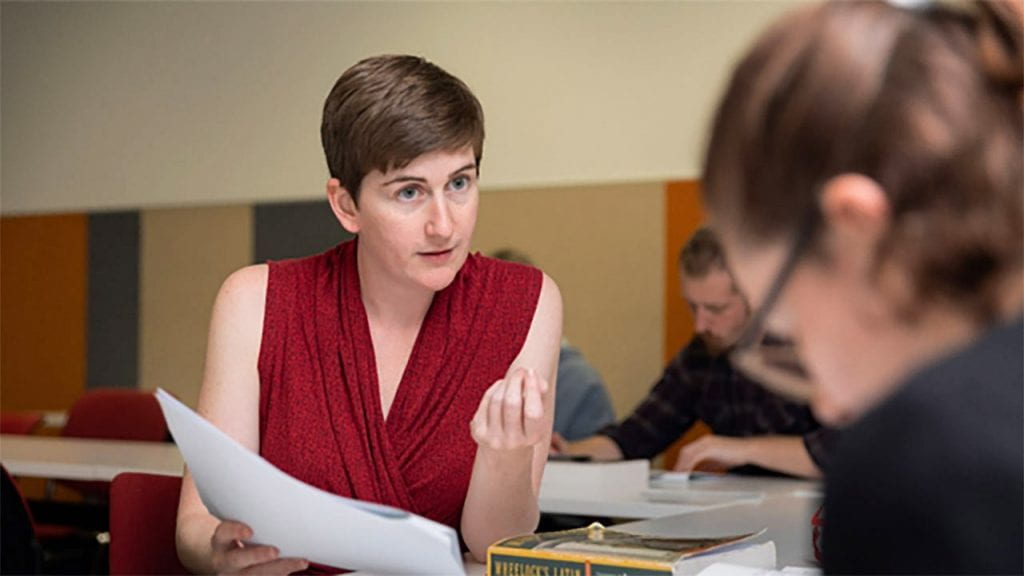Making classics and ancient history accessible, inclusive and relevant
Maxine Lewis is a Senior Lecturer, in Classics and Ancient History, School of Humanities, Faculty of Arts and Assistant Dean Equity, Faculty of Arts. She teaches from first year undergraduate to Masters students, in a range of courses including ancient Greek and Latin language and literature, and Greek and Roman history and culture, taught in translation. Maxine has won a number of teaching awards.
“I feel privileged to teach subjects that I am passionate about to enthusiastic students from whom I learn so much. I am deeply committed to bringing knowledge of the ancient Greek and Roman world to students in Aotearoa New Zealand, while celebrating how their own worldviews shed new light on this ancient material.”
Maxine discusses relationality in her teaching practice.

Manaakitanga: Enabling students to bring their whole selves
Maxine has long been committed to creating equitable teaching and learning spaces, drawing on feminist principles. Since moving from Australia to Aotearoa, she has been lucky to receive mentorship through the Ako Arts programme which supports teaching staff to embed Māori and Pacific worldviews in the classroom.
Maxine extends manaakitanga by building in opportunities for students connect personally to the material she teaches. In one large lecture course on myth and storytelling, she invites students to share a myth that has personal significance for them, and shares her own. She then builds the students’ myths and cultural backgrounds into the course content throughout the semester. In smaller classes, Maxine has encouraged students to co-design assessments, allowing them to pursue topics that speak most to them. Students share their draft assessments with each other, giving and receiving feedback in a supportive environment.
Maxine intends her acts of manaakitanga to function on multiple levels. They allow Maxine to get to know each student, creating meaningful connections. Helping students find a personal connection to the subject matter nurtures their relationship to the discipline, by increasing their motivation and level of engagement. Peer-to-peer sharing of unique assessments helps students to learn about each other’s perspectives, and generates a community of practitioners. Overall, Maxine seeks to generate a strong community and sense of whanaungatanga.
These examples of manaakitanga also aim to upend earlier Western approaches of treating the ancient Greek and Roman canon as a Tree of Knowledge. Students do not simply imbibe the nectar: they pollinate, bringing, sharing, and spreading their own insights around the garden. In doing so, they keep the tree alive, and more importantly, help it evolve.
(Connection between students and teachers)
(Connection with peers)
(Connection with subject)
Inclusive learning
For Maxine, learning arises through students’ relationships with her, each other and the subject material. So, if there are barriers to those relationships, it is her job to remove them.
For LGBTQIA, Takatāpui and MVPFAFF+ youth, Maxine strives to create an inclusive learning environment. Maxine elaborates: “As a young, queer student I had no out lesbian or gay teachers. I experienced and witnessed homophobia both inside the classroom and outside. These experiences badly impacted on my self-esteem, and on my sense of place and belonging in the classroom. Research shows that emotional states affect learning (see, for example, Mayes 2019 and Ng 2015), so I aim to make sure my LGBTQIA/takatāpui students do not have their own learning environments compromised by negative emotions, such as shame and anger, caused by experiencing homophobia.” (p. 50)1
Practical ways Maxine supports her LGBTQIA, Takatāpui and MVPFAFF+ students include:
- Including her pronouns in her email signature
- ‘Coming out’ to students early on in her courses
- Scaffolding discussions on difficult or sensitive topics
- Offering course content and assessments, on Greco-Roman texts that depict same-sex desire and fluid gender practices)
- Being available for individual conversations with students.
These strategies allow rainbow students to connect with Maxine as they know she is a supportive member of the community. These steps also signal to all students that the classroom will be a respectful place for learning, shaping the peer-to-peer dynamic.
Maxine also seeks to remove barriers to engaging with her subject for students with disabilities. She uses accessibility checkers and invites students to let her know if her course materials need adjusting for accessibility. Recently, Maxine has experimented with assessment formats using Universal Design for Learning principles.
(Connection between students and teachers)
(Connection with peers)
(Connection with subject)
(Connection with selves)
Interactive learning
Maxine has always loved generating interactions in her classes, especially peer-to-peer collaborations. Her ideal teaching situation is dynamic, with energy flowing in all directions between teacher, students, and the subject matter itself. Maxine strives to create a welcoming tauhi vā, a space, among the cohort. She always learns students’ names, invites comments, and thanks students who bring questions. She uses pair and small-group exercises to foster connections among students. She employs games and songs to break up content blocks, and allow fun and physical interactivity.
The emergency pivot to remote teaching in 2020 posed a challenge to Maxine’s usual ways of fostering interactivity. To level up, Maxine took courses on online teaching and started using tools such as H5P, Padlet and Perusall to enable peer-to-peer learning and interaction with content even when students couldn’t be on campus. After a difficult start to the pandemic, Maxine has found that these tools allow her to extend the tauhi vā into the digital realm.
Maxine sums up, “I’m a people person and I care about students as whole people. I’m very passionate about my subjects and about finding out what the students think about them, which shapes how I relate to and interact with them.”
(Connection between students and teacher)
(Connection with peers)
(Connection with subject)
- Rātima, Matiu Tai, Jennifer Pearl Smith, Angus Hikairo Macfarlane, Nathan Mahikai Riki, Kay-Lee Jones and Lisa Kaye Davies, eds. Ngā hau e whā o Tāwhirimātea: Culturally responsive teaching and learning for the tertiary sector. University of Canterbury Press, 2022. ↩
